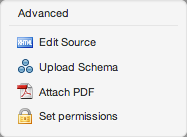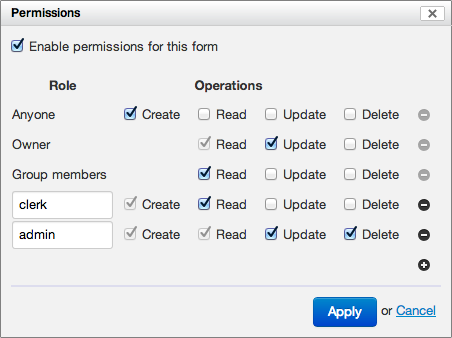Access Control for Deployed Forms
- Enabling permissions
- Setting permissions
- Example
- Permissions dialog
- Permissions for owner / group members
- Access restrictions
Enabling permissions
For forms created in Form Builder, you can restrict which users can access which forms, and what operations they can perform. Those restrictions apply to the forms you create once they are deployed, not to editing those forms in Form Builder (for the latter, see the section that follows: Access control for editing forms).
By default, no restriction is imposed on who can do what with forms you create in Form Builder. You enable permissions by going to the Form Builder sidebar, and under Advanced, clicking on Set Permissions.

This shows the following dialog:

Setting permissions
After you click on the checkbox, you'll be able to set access restriction on the create, read, update, and delete operations:
- On the Anyone line, set the operations allowed to all users.
- On the Owner line, set the operations allowed to the user who created the data. [SINCE Orbeon Forms 4.3]
- On the_Group members_line, set the operations allowed to users in the same group as the owner. [SINCE Orbeon Forms 4.3]
- On the following lines, you can enter a role name, and define what operations users with that role can perform.
Example
In the example below:
- Any user to fill out a new form.
- Users with the role _clerk_to read data.
- Users with the role admin to do any operation, including deleting form data.

Permissions dialog
- Permissions you set in the dialog are additive –Say you defined permissions for two roles, where users with thereader_role can read and users in the_clerk_role can delete, users with both roles (_reader_and_clerk)are allowed to perform both operations (reading and deleting).
- Operation on Anyone apply to all other rows – When you select a checkbox for a given operation on the first Anyone row, that checkbox will be automatically checked and disabled so you can't change it, for any additional row, since you wouldn't want to authorize users with additional roles to perform less operations.
- Update implies read – On any row, if you check update, then read will be automatically checked, as it wouldn't make sense to say that some users can update data, but can't read it, as when updating data, obviously, they must be shown the data they are updating.
- Create can't be set for the owner and group members – The owner/group is a piece of information attached to existing form data, keeping track of the user who create the data, and the group in which this user is. This information is only known for existing data, so assigning the create permission to the owner or group members doesn't make sense, and the dialog doesn't show that checkbox.
- Permissions for the owner and group members can be set independently– If you want data to be accessible only by people who created it, check read/update/delete for the owner but not for group members. If you want data to be accessible by all people in the same group,check read/update/delete for the group members and don't check them for the owner if you want the owner to lose access to that data in case the owner changes group. (The latter highlights the need for permissions owner and group member to be set independently.)
Permissions for owner / group members
See Owner and Group Member Permissions.
Access restrictions
Which operations the current user can perform drives what page they can access, and on some pages which buttons are shown:
On the Form Runner home page, all the forms on which the current user can perform at least one operation are displayed. Then, for each one of those forms:
- If they can perform the create operation on the form, a link to the new page is shown.
- If they can perform any of the read, update, or delete operation on the form, a link to the summary page for that form is shown.
For the summary page:
- Access is completely denied if the current user can't perform any of the read, update, or delete operations.
- The delete button is disabled if the current user can't perform the delete operation.
- The review and pdf button are disabled if the current user can't perform the read operation.
- Clicking in a row of the table will open the form in edit mode if the current user can perform the update operation, in view mode if they can perform the read operation, and do nothing otherwise.
For the view page, access is denied if the current user can't perform the read operation.
- For the new page, access is denied if the current user can't perform the create operation.
- For the edit page, access is denied if the current user can't perform the update operation.
[SINCE 4.3] In Orbeon Forms 4.2 and earlier, role-based permissions set in Form Builder could only be driven by container-based roles and the value of the oxf.fr.authentication.method property was not taken into account. Since version 4.3, those permissions also apply if you are using header-driven roles.